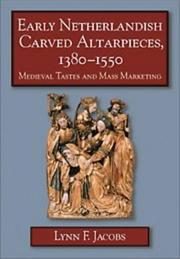| Listing 1 - 3 of 3 |
Sort by
|

ISBN: 0521474833 Year: 1998 Publisher: Cambridge Cambridge University Press
Abstract | Keywords | Export | Availability | Bookmark
 Loading...
Loading...Choose an application
- Reference Manager
- EndNote
- RefWorks (Direct export to RefWorks)
sculpting --- History --- Sculpture --- taste [aesthetics] --- retables [altar appendages] --- altarpieces --- ateliers [studios, organizations] --- mass production --- Medieval [European] --- Applied arts. Arts and crafts --- anno 1400-1499 --- anno 1300-1399 --- anno 1500-1599 --- Netherlands --- Altarpieces, Flemish. --- Altarpieces, Gothic --- Wood-carving, Gothic --- Altarpieces --- Retables flamands --- Retables gothiques --- Sculpture sur bois gothique --- Retables --- Marketing --- Commercialisation --- 7.046.3 --- -Altarpieces, Gothic --- -Wood-carving --- -Wood-carving, Gothic --- -Altarpieces, Flemish --- Flemish altarpieces --- Gothic wood-carving --- Whittling --- Wood-carving, Primitive --- Wood carvings --- Wood craft --- Woodcarving --- Woodcraft --- Carving (Decorative arts) --- Woodwork --- Wood sculpture --- Gothic altarpieces --- Predellas --- Reredos --- Screens (Church decoration) --- Iconografie: religieuze voorstellingen --- Wood-carving --- Marketing. --- 7.046.3 Iconografie: religieuze voorstellingen --- retables [altar appendage] --- Altarpieces, Flemish --- cultuurgeschiedenis --- Nederlandse school --- beeldhouwkunst, Nederlanden --- History of Belgium and Luxembourg --- woodcarving [process] --- Christianity --- Late Medieval --- religious art --- Netherlandish
Book
ISBN: 9780271048406 0271048409 Year: 2012 Publisher: University Park: Pennsylvania state university press,
Abstract | Keywords | Export | Availability | Bookmark
 Loading...
Loading...Choose an application
- Reference Manager
- EndNote
- RefWorks (Direct export to RefWorks)
"A study of Netherlandish triptychs from the early fifteenth century through the early seventeenth century, covering works by Jan van Eyck, Rogier van der Weyden, Hugo van der Goes, Hieronymus Bosch, and Peter Paul Rubens. Explores how the triptych format structures and generates meaning"--Provided by publisher.
Triptychs --- Painting, Netherlandish --- triptychs --- Triptyques --- Painting --- anno 1400-1499 --- anno 1600-1699 --- anno 1500-1599 --- Flanders --- Triptychs - Netherlands --- Triptychs - Belgium --- Vlaamse school
Book
ISBN: 904854355X 9463725407 9789463725408 Year: 2022 Publisher: Amsterdam : Amsterdam University Press,
Abstract | Keywords | Export | Availability | Bookmark
 Loading...
Loading...Choose an application
- Reference Manager
- EndNote
- RefWorks (Direct export to RefWorks)
This book presents four case studies that interrogate how German fifteenth-century painted triptychs engage with, and ultimately blur various boundaries. Some of the boundaries are internal to the triptych format, for example, transgressed frames between narratives scenes on triptychs' interiors, or interconnections between imagery on triptychs' interiors and exteriors. Other blurred boundaries are regional ones between the Netherlands and Cologne; metaphysical ones between heaven and earth; and artistic distinctions between the media of painting and sculpture. The book's case studies, which shed new light on Conrad von Soest, Stefan Lochner, and the Master of the St Bartholomew Altarpiece, illuminate the importance of German fifteenth-century painting, while providing a fresh assessment of relations between German triptychs and their more famous Netherlandish counterparts' and demonstrating the value of probing Medialität, the implications of format and medium for generating meaning. The book's coda assesses the triptych in the age of Dürer.
| Listing 1 - 3 of 3 |
Sort by
|

 Search
Search Feedback
Feedback About UniCat
About UniCat  Help
Help News
News